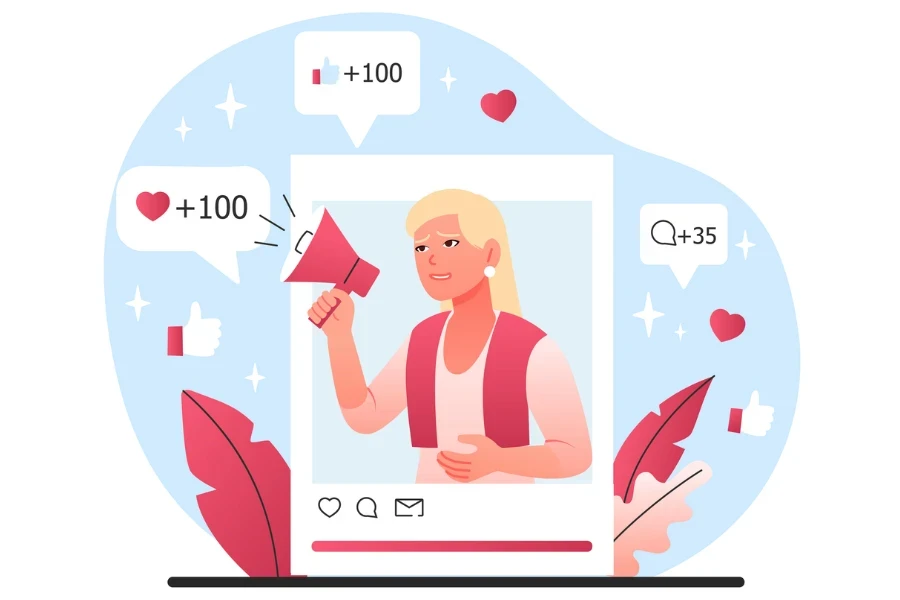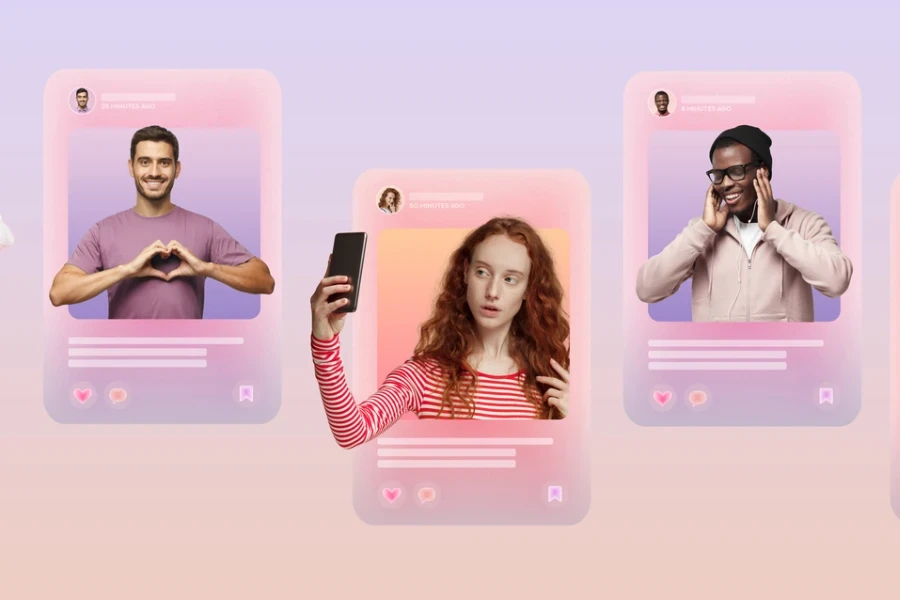If you’ve been on social media, you’ve seen user-generated content. You know, the videos where people show themselves unboxing a haul of products from a company or reviewing a product for their followers—that’s user-generated content.
User-generated content can be leveraged by brands to connect with their target audience in a genuine way. Here, you will learn more about user-generated content, why it’s important in social media marketing, and how your brand can leverage it as part of its marketing strategy.
Table of Contents
What is user-generated content?
Why is user-generated content important for social media marketing?
Strategies for leveraging user-generated content
UGC best practices
Final thoughts
What is user-generated content?
User-generated content (UGC) refers to any form of content, such as text, images, videos, reviews, or comments, created by users or consumers rather than professional creators or brands. It can be found on various online platforms, including social media sites, forums, blogs, and review websites.
In an era where intrusive marketing tactics often annoy consumers, user-generated content (UGC) has emerged as a favored strategy among leading brands. UGC is used by all the top brands, even Apple and Disney, to engage more authentically with consumers.
The value of the global UGC market in 2022 was US $4.4 billion and is projected to grow at a compound annual growth rate (CAGR) of 29.4% from 2023 to 2030.
Examples of user-generated content include:
- Social media posts and updates shared by individuals.
- Photos and videos uploaded by users on platforms like Instagram, TikTok, and YouTube.
- Product reviews and ratings written by customers on e-commerce websites like Amazon or Yelp.
- Comments and discussions on forums, message boards, and community websites.
- Blogs and articles written by individuals on personal or niche websites.
User-generated content is valuable for businesses and marketers because it can provide authentic insights into consumer experiences, preferences, and behaviors. It can also be a powerful tool for building community, engaging audiences, and increasing brand credibility and trust.
Why is user-generated content important for social media marketing?

Consumers are bombarded with numerous ads daily, so it’s easy for ads to be ignored. People are more likely to engage with one another, and according to the State of Social & User-Generated Content 2023, consumers rank authentic UGC as the most trustworthy content.
These are some of the benefits of user-generated content:
- Authenticity and trust: When people see real users sharing their experiences, they’re more likely to trust the recommendations and opinions conveyed in UGC.
- Engagement and community building: UGC fosters engagement and creates a sense of community among followers. By encouraging users to contribute their content and participate in discussions, brands can create a deeper connection with their audience.
- Cost-effectiveness: User-generated content can be a cost-effective marketing strategy because it requires minimal investment in content creation. Instead of producing all the content themselves, brands can tap into the creativity and enthusiasm of their audience.
- Social proof and influence: Positive user-generated content serves as social proof of a brand’s value and credibility. When potential customers see others enjoying a product or service, it can influence their purchasing decisions and drive conversions.
- Virality and reach: Compelling user-generated content has the potential to go viral and reach a wider audience organically. Whether it’s a trending hashtag challenge or a heartfelt testimonial, UGC has the power to amplify brand visibility and awareness.
Strategies for leveraging user-generated content
Now that we understand the importance of user-generated content in social media marketing, let’s explore some effective strategies for leveraging UGC to benefit your brand:
1. Encourage user participation
Actively encourage your followers to contribute their content by hosting contests, challenges, or giveaways. Whether it’s a photo contest showcasing your products or a creative hashtag challenge, incentivize users to get involved and share their experiences.
For example, Starbucks’ #StarbucksRedCupContest invites customers to share photos of their festive holiday cups, generating excitement and user engagement.
2. Showcase user content and stories
Regularly feature user-generated content on your social media channels, website, or marketing materials. Highlighting real-life testimonials, reviews, and photos adds authenticity to your brand and shows appreciation for your loyal customers.
Airbnb’s Instagram account is a prime example, as they frequently share stunning photos and stories from their hosts and guests, showcasing real-life experiences and inspiring wanderlust.
Another great way to engage with consumers is to show your users’ success stories. Engage directly with users and show authentic examples of how your brand positively impacts people; this could include before-and-after scenarios, for example.
3. Engage and interact
Engage with users who create content related to your brand by liking, commenting on, or sharing their posts. Show genuine appreciation for their contributions and foster a sense of community by responding to comments and messages.
4. Create branded hashtags
Develop branded hashtags that encourage users to share content related to your brand or products. Creating a dedicated hashtag makes it easier for users to discover and contribute UGC, while also increasing brand visibility and recognition.
GoPro‘s #GoProTravel is a popular hashtag that encourages users to share their adventures captured with GoPro cameras, allowing the brand to curate a collection of stunning travel content shared by their community.
5. Collaborate with influencers
Partner with influencers who align with your brand values and target audience. Collaborating with influencers can help amplify user-generated content and reach new audiences while leveraging their expertise and credibility.
Fashion retailer ASOS frequently collaborates with fashion influencers and content creators to showcase user-generated styling inspiration, leveraging their influence to reach a wider audience.
Learn more about influencer marketing, including choosing the right influencer for your brand.
6. Incorporate UGC into marketing campaigns
Integrate user-generated content into your marketing campaigns across various channels, including social media, email, and advertising. Whether creating a user-generated video montage or featuring customer testimonials in an ad campaign, leverage UGC to enhance the effectiveness of your marketing efforts.
UGC best practices

Here are some key best practices for businesses when it comes to leveraging UGC:
Determine your business goals
Before jumping into campaigns focused on user-generated content, you need to determine the goals of the campaign, as this will determine the best approach. For example, if you want to boost brand awareness, a hashtag campaign may be the right idea. However, to increase conversions, you may want to focus on soliciting positive reviews.
Establish clear guidelines
Define clear guidelines and policies for user-generated content to ensure that it aligns with your brand values, messaging, and legal requirements. Provide users with clear instructions on what types of content are acceptable and appropriate for sharing.
Remember that often, user-generated content requires an offer in exchange. So, ensure you know what you are willing to offer for user-generated content, and that the rules are clear to your audience. Also, remember that the offer should be proportional to the effort needed to create the content.
Be transparent and honest
Be transparent and honest with your audience about how your brand uses, displays, or repurposes user-generated content. Communicate your intentions, and allow users to opt-out or request the removal of their content if desired.
Consult a legal specialist
Navigating the legal aspects of a user-generated content (UGC) campaign can present challenges for businesses. Depending on your location and the platform used for content collection, regulations surrounding giveaways and user-generated content rights can be intricate. It’s essential to seek guidance from legal experts before incorporating any UGC into your marketing efforts.
Consulting with legal specialists ensures compliance with relevant laws and regulations, safeguarding your brand from potential legal risks and liabilities. Additionally, respect user privacy and rights when collecting, using, or sharing user-generated content. Obtain consent from users before featuring their content publicly, and ensure compliance with applicable data protection and copyright laws.
Stay active and engaged
Stay active and engaged with your audience on social media platforms and other channels where user-generated content is shared. Regularly monitor discussions, respond to feedback, and participate in relevant conversations to maintain a positive brand presence.
Measure and analyze performance
Measure the performance and impact of user-generated content on your marketing efforts using relevant metrics and analytics tools. Track key performance indicators such as engagement, reach, conversions, and sentiment to evaluate the effectiveness of your UGC strategies and make data-driven decisions for optimization.
Final thoughts

User-generated content has emerged as a powerful tool for brands to engage, inspire, and connect with their audience in social media marketing.
By harnessing the creativity and authenticity of their users, businesses can build trust, foster community, and drive meaningful interactions that ultimately contribute to their success in the digital landscape. Embrace the power of user-generated content and watch as your brand flourishes in the age of social media.




